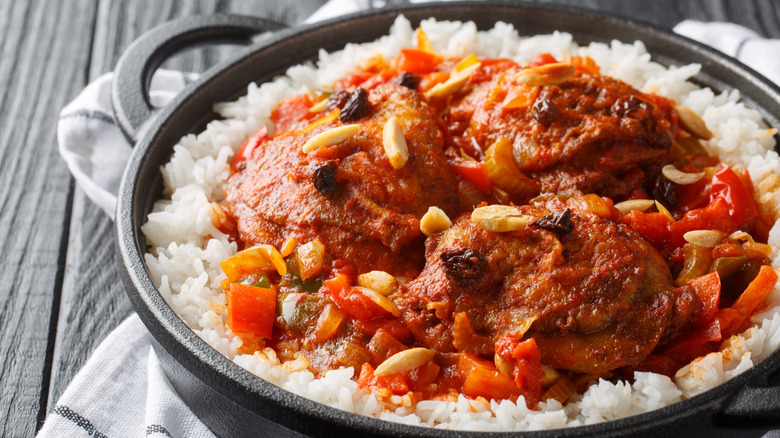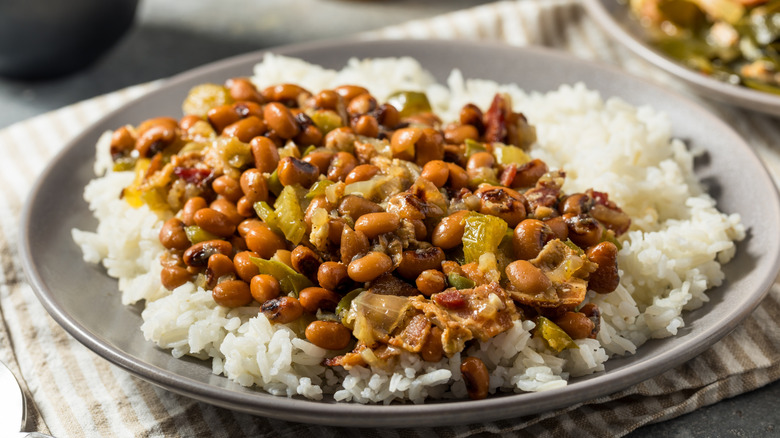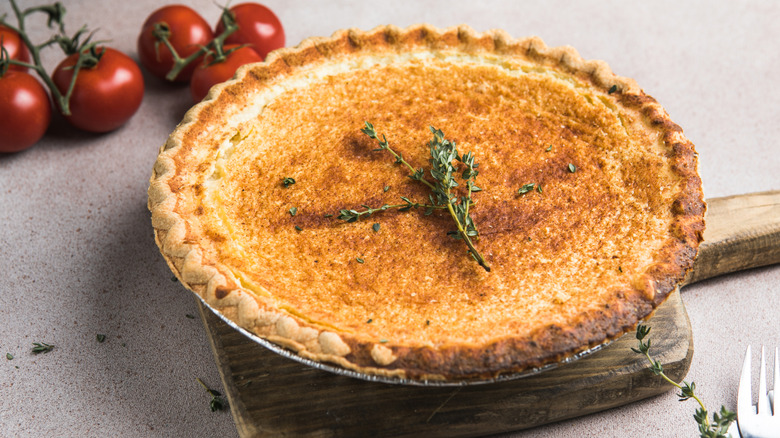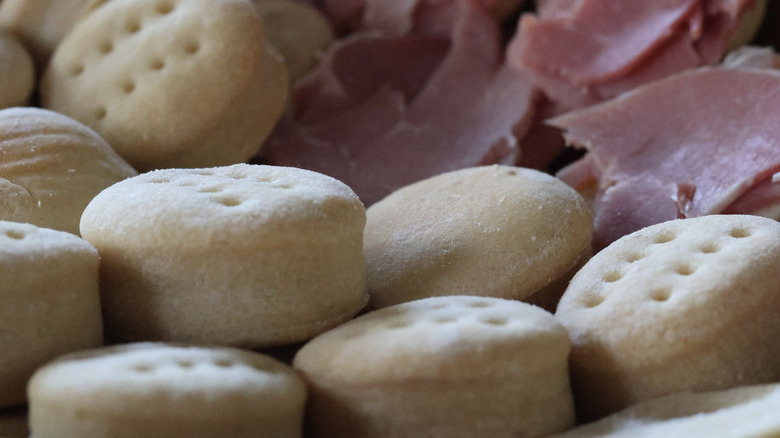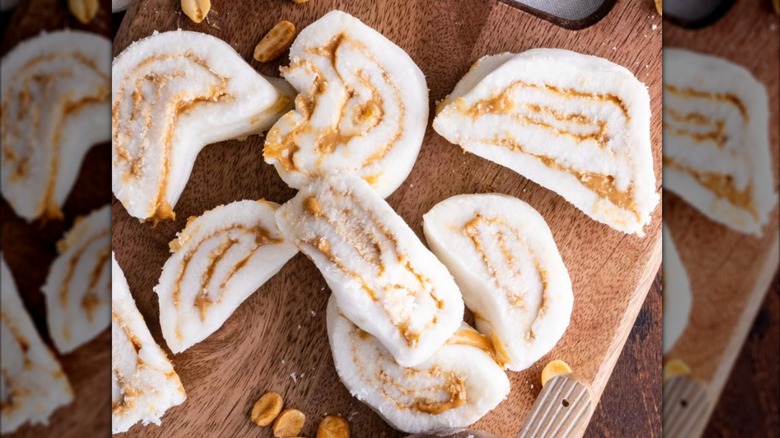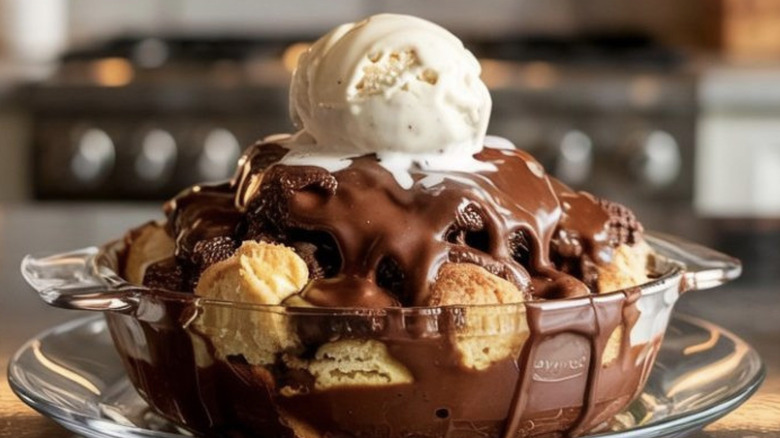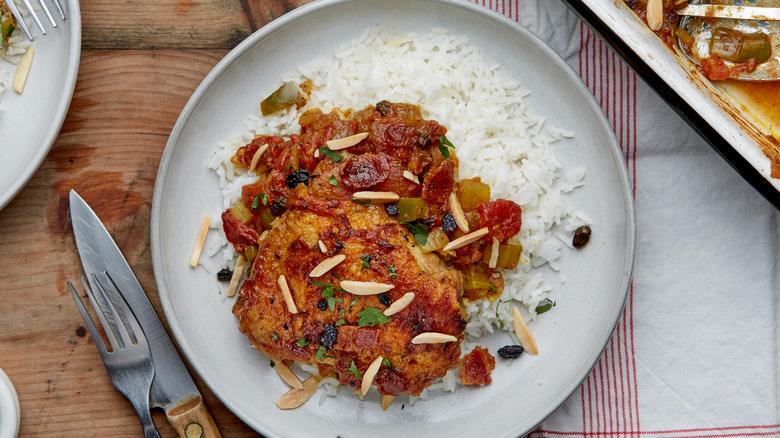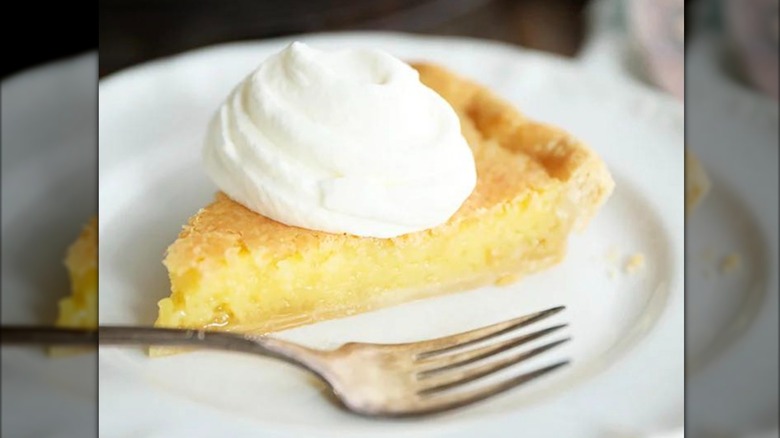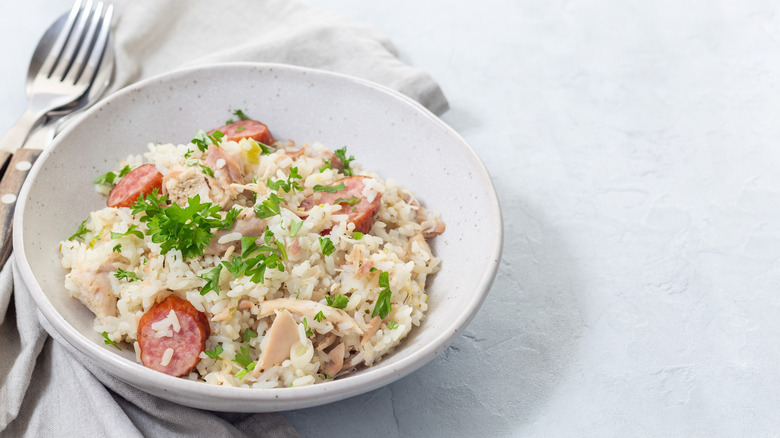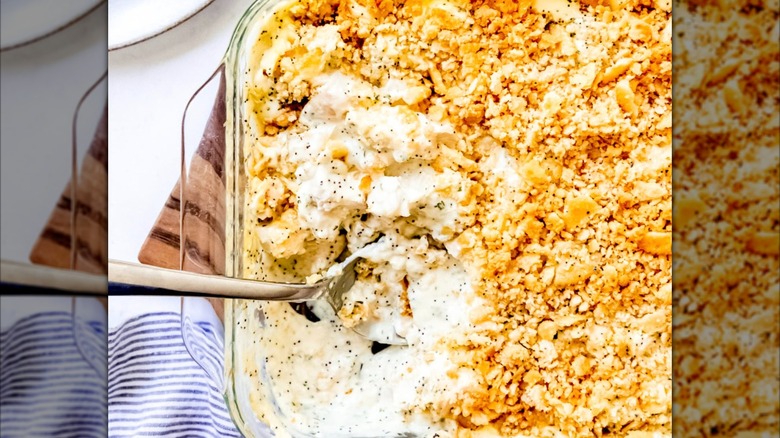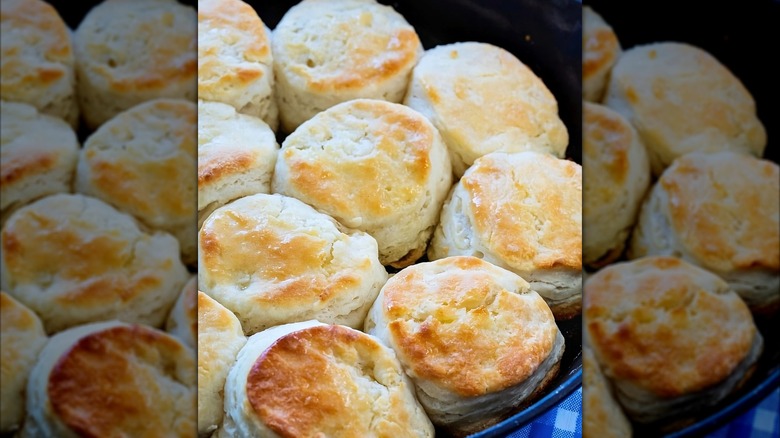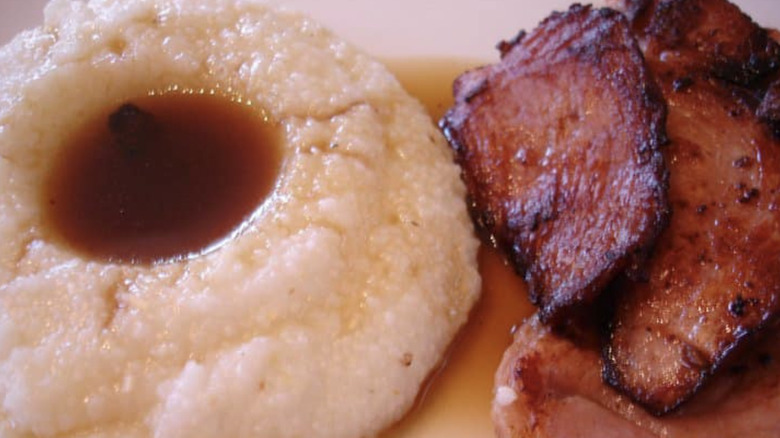Vintage Southern Foods We Desperately Want Back In Our Lives
We may receive a commission on purchases made from links.
Drawing on African, European, and Indigenous influences, Southern food tends to be hearty and comforting. This beloved regional cuisine evolved over centuries — a result of the melding of Indigenous crops like tomatoes, corn, and squash, European staples such as sugar, flour, and milk, and African ingredients like okra and black-eyed peas. Over time, these diverse ingredients — and culinary traditions — gave birth to the rich and flavorful Southern-style dishes that we still enjoy today.
When we think of Southern food, we usually conjure up images of crowd-pleasers like biscuits and gravy, fried chicken, gumbo, and jambalaya. However, beyond these popular classics lies a treasure trove of vintage Southern recipes just waiting to be rediscovered. These lesser-known specialties were once beloved staples at potlucks, Sunday dinners, and seasonal celebrations, only to fade into obscurity over time. Whether due to changing tastes, the rise of convenience food, or shifts in dietary preferences, these recipes have gradually disappeared from most kitchens.
Ready to learn about old-school Southern recipes that deserve a spot on our tables? Check out these forgotten favorites that are due for a comeback!
Chicken mull
It may not be as well-known as Brunswick stew or gumbo, but a buttery bowlful of chicken mull definitely holds its own when it comes to flavor. This yellow-hued dish is made with shredded chicken simmered in a rich, creamy broth, which is thickened with crushed saltines. Chicken mull is often considered as a traditional barbecue stew, because it used to be prepared in huge communal pots and served at large gatherings such as fundraisers and church socials.
The roots of chicken mull are believed to be tied to 19th-century fish cookouts — called "muddles" — that were held by Atlantic coast fishermen, which typically included a savory mush of bass, potatoes, onions, and spices. As the tradition moved inland through the Southern states, fish was replaced with poultry, and the name evolved from "muddle" to "mull." Today, chicken mull is still served at some Southern eateries, particularly in Georgia, where it's commonly accompanied by saltine crackers. Chicken mull also endures in certain parts of North Carolina, where the town of Bear Grass even celebrates the dish with an annual festival.
Hoppin' John
Hoppin' John is a Southern dish with roots in African culinary traditions. Introduced to the American South by enslaved Africans, it originated as a one-pot meal of rice, black-eyed peas, and pork (more specifically, bacon or ham hock). The dish was a popular mainstay of Gullah Geechee cuisine that originated in the Lowcountry of South Carolina. Standing as a testament to the rich flavor of hoppin' John, it didn't take long for this dish to be adopted by broader Southern society, as evidenced by its inclusion in Sarah Rutledge's 1847 cookbook, "Carolina Housewife."
Today, hoppin' John comes in countless variations, with some recipes incorporating ingredients such as butter, garlic, and varied vegetables. While not everyone agrees on a single hoppin' John recipe, one thing is certain — its name is as attention-grabbing as it is puzzling. Unfortunately, the origins of the name are unclear, although some believe that it may be linked to the French phrase "pois à pigeon," which translates to "pigeon peas." Beyond its unusual name, hoppin' John used to be frequently enjoyed on New Year's Day as a lucky food to bring wealth and good fortune in the coming year.
Chess pie
Likely evolving from English cheese pies, chess pie was probably first documented in print in 1866, when a recipe for the dessert appeared in "The American Agriculturalist." The instructions called for eggs, cream, sugar, butter, flour, and nutmeg. Today, recipes for this sweet Southern dessert can also include ingredients like vanilla extract, cornmeal, and white vinegar. Once combined, the filling is poured into a buttery pie crust and baked.
While it may not be as popular as it once was, chess pie represents Southern food traditions handed down through generations. This gooey treat is made from basic ingredients found in most pantries, which no doubt made it a practical and comforting dessert during hard economic times. With its ingredients including plenty of sugar, chess pie also has a long shelf life — a definite bonus at times when refrigeration was still a luxury. In fact, the dessert was often stored in pie safes, which were wooden cupboards with ventilation panels used to keep baked goods cool and to protect them from rodents.
Beaten biscuits
Southern beaten biscuits owe their intriguing name to their preparation process. This is because the dough for these biscuits is beaten with rolling pins, hammers, and even axe handles for at least 15 minutes until it blistered. The dough is then shaped into circles and perforated with a fork before being placed in the oven. This rigorous pounding helped to incorporate air into the biscuits by creating layers in the dough, which inflated in the oven to provide a desirable texture. This technique was particularly popular among 19th-century Southerners who lacked baking powder, as it gave the biscuits a lift.
While today most bakers use baking powder — rather than brute force — to give their biscuits texture, beaten biscuits are a noteworthy relic of traditional Southern cooking. In fact, some traditionalists still praise them for their dense, cracker-like texture. Home bakers wishing to put a little elbow grease into their snacks can make these savory bites at home with a few simple ingredients like flour, butter, milk, salt, and sugar. And anyone who is curious about beaten biscuits but not willing to break a sweat for them can simplify the process by adding a little baking powder into the mix.
Potato candy
What makes potato candy stand out from the pack is its starchy base. Normally associated with savory dishes, potatoes make an unconventional — yet surprisingly creamy — canvas for the sweet flavors of this recipe. What is not surprising is that potato candy reportedly made its debut in the Southern U.S. during the Great Depression, a time when home cooks had to stretch limited ingredients as far as possible.
Potato candy requires few ingredients. Aside from potatoes, the recipe calls for powdered sugar, milk, peanut butter, vanilla extract, and salt. To make the dough, simply combine all the ingredients except peanut butter and roll it out into a flat sheet. Slather the dough with peanut butter and roll it up into a log. Place the roll in the freezer for around an hour and slice it into circles.
Potato candy shouldn't be confused with Irish potato candy, which is a completely different recipe. While both treats are sweet, Irish potato candy doesn't actually contain potatoes. Instead, the snack is made with cream cheese, coconut, and sugar. As for its name, it likely stems from the candy's appearance, since the ingredients are shaped into balls and coated in cinnamon to resemble brown potatoes.
Chocolate cobbler
Cobblers, as we typically know them, are casserole-style desserts featuring syrupy fruit fillings topped with a doughy crust. Unlike traditional cobblers, the Southern version of this dessert uses chocolate as the main ingredient, combining a cake-like crust with a soft, gooey center. In fact, some have likened the chocolate cobbler to a fusion of chocolate pudding and molten lava cake.
Chocolate cobbler became popular as a budget-friendly and no-fuss dessert option during the Great Depression due to its simple ingredients and ease of preparation. Made with pantry staples like flour, sugar, cocoa, and baking powder, chocolate cobbler requires no special equipment. All you need to do to make it is combine the dry ingredients with milk, butter, and vanilla extract, and cover them with a layer of sugar and cocoa. The recipe comes together when boiling water is poured over the batter just before baking. As the cobbler cooks, the water sinks through the batter, creating a rich chocolate sauce at the bottom while the top of the dessert transforms into a crispy cake-like layer. Add a scoop of vanilla ice cream to make this confection complete.
Country captain chicken
Country captain chicken has a unique origin — this classic Southern dish likely has roots in Anglo‑Indian cuisine. While the exact history of the dish is shrouded in mystery, this mildly curried chicken stew is said to have been introduced to the U.S. by a British seaman who had previously been in India during the 1800s. Since British officers stationed in India at the time were called "country captains," and country captain chicken is a Westernized version of an Indian dish, it's easy to see why the name became attached to it.
The recipe for country captain chicken was purportedly first documented in "Miss Leslie's New Cookery Book" in 1857. This take on the dish combined boiled chicken flavored with curry powder, which was then fried with onions and optional grated coconut. Just like Indian curries of today, the dish was usually served with rice.
The country captain chicken recipe underwent a notable revival in 1906 when Alessandro Filippini — who worked as a chef at New York's famed Delmonico's restaurant — published a new version of this dish in his "International Cook Book." Filippini's take on the dish included green peppers, garlic, thyme, and parsley, as well as a topping of roasted almonds and dried currants. The dish was further transformed in the 1920s when a doctor's wife in Columbus, Georgia known as "Miss Mamie" Bullard collaborated with her cook, Arie Mullins, to add preserved tomatoes to the mix. Miss Mamie is said to have even served her version of country captain chicken to Franklin Delano Roosevelt at one of her dinner parties.
Hoecakes
Despite their evocative name, hoecakes look more like flatbreads or pancakes than cakes. While they are typically prepared on a skillet or a hot griddle until golden and crispy, this may not always have been the case in the past. According to folklore, hoecakes were once cooked on the flat side of a hoe over an open fire. However, it's much more likely that hoecakes get their name from the word "hoe," which was commonly used to refer to a griddle in 17th-century England.
So what exactly are hoecakes? Also sometimes referred to as Johnny cakes, hoecakes are a type of old-school flatbread originally made with three simple ingredients — cornmeal, salt, and water. Over time, hoecake recipes evolved to include a range of other items like butter, eggs, sugar, baking powder, and buttermilk. While the exact history of hoecakes isn't clear-cut, this simple specialty was already documented in an American cookbook by the mid-1700s. Hoecakes were also frequently prepared by enslaved African-Americans who had limited access to cooking ingredients and tools.
Vinegar pie
The history of vinegar pie is often associated with the Great Depression and times of economic struggle, as it offered a way to create a tangy-sweet dessert without relying on fresh fruit. Nevertheless, this Southern confection originated long before the 1930s. One of the earliest recipes for a vinegar pie-style dessert appeared in Marion L. Scott's 1855 cookbook, "The Practical Housekeeper, and Young Woman's Friend." This version of the sweet treat called for a mixture of brown sugar, vinegar, lemon, flour, and water — all baked in a double-pie crust. The Great Depression version of vinegar pie often featured ingredients such as eggs and butter, reflecting slightly more indulgent pantry options.
What makes vinegar pie so incredible is its simplicity and balance of flavors, with vinegar being a surprisingly effective substitute for lemons or limes. In fact, many dessert enthusiasts are quick to comment that vinegar pie doesn't actually taste like vinegar. Instead, the ingredient gives the pie a gentle and desirable tartness that cuts through its sweetness.
Chicken bog
If a bog refers to a type of wetland, then what exactly is chicken bog? Despite its name, chicken bog is neither muddy nor swampy. Instead, it's a beloved Southern comfort food made with chicken, rice, and smoked sausage. Originating in the Lowcountry and Pee Dee regions of South Carolina, chicken bog is a one-pot meal in which all the ingredients are simmered together until their flavors meld into a rich, savory stew. Breaking with tradition, some more modern chicken bog recipes also call for onions, green peppers, and other vegetables.
Chicken bog is best-known in South Carolina's Horry County, which includes Myrtle Beach. Each year, both locals and visitors gather there to celebrate the pilaf-style dish at the Loris Bog-Off Festival. Launched in 1980 as a local chicken bog cooking competition, the event has since transformed into a community tradition, complete with craft vendors, food, and diverse entertainment. It goes without saying that the festival still hosts chicken bog cooking contests, with both professional and amateur chefs competing for cash prizes and culinary glory.
Poppy seed chicken
Poppy seed chicken is characterized by its contrast of textures. Each forkful of this casserole-style dish offers a combination of a creamy chicken filling and a topping of buttery crackers. And while the poppy seeds may not add much to the overall flavor profile of the dish, they certainly give it visual flair. Once a staple at church potlucks and family gatherings, today poppy seed chicken has taken a back seat to trendier casseroles. Nevertheless, this retro favorite continues to hold its own in some Southern kitchens.
Delicious, comforting, and easy to prepare, poppy seed chicken has everything you could possibly ask for in a Southern-style dish. Not only does it utilize common pantry staples, but it can be prepared in one dish, minimizing time spent washing dishes. All you need to make this classic specialty are six simple ingredients — chicken (if you are short on time, this can be one of the great weeknight meals to make with a rotisserie chicken), cream of chicken soup, sour cream, poppy seeds, buttery crackers, and unsalted butter.
Angel biscuits
From biscuits and gravy to classic hush puppies, simple yet satisfying comfort foods have been Southern staples for generations — and angel biscuits are no exception. Likely invented during the first half of the 20th century, the light and fluffy biscuits are unusual in that they use yeast, baking soda, and baking powder to provide texture and flavor. Standard biscuits normally only incorporate either baking powder or baking soda. While it's unclear who first came up with the idea of using three leaveners at the same time, flour brands White Lily and Martha White have both received credit for spreading the popularity of angel biscuits across the South.
Aside from the leavening agents, angel biscuits incorporate flour, buttermilk, vegetable shortening or lard, salt, and sugar. Yeasty and mildly sweet, the biscuits pair well with just about anything. They can be enjoyed for breakfast alongside scrambled eggs and bacon, used to make country ham biscuits, or served to accompany hearty dishes such as fried chicken or country-fried steak.
Red-eye gravy
Quick and easy to make, red-eye gravy was once a popular staple in the American South. Unlike many thicker gravies — like rich sausage gravy — red-eye gravy requires no flour or milk. Instead, it relies solely on two readily available ingredients: country ham drippings and leftover coffee. The difference between city ham and country ham is that the latter is salt-cured and aged for months or even years, and it's a staple of traditional Southern cooking.
Also called bird-eye gravy, muddy gravy, and poor man's gravy, red-eye gravy may have gotten its name due to its presentation. Once poured into the pan, the contrast between the coffee and the juicy ham drippings can make the saucy concoction resemble a pupil and an iris.
To make red-eye gravy, fry country ham in a skillet and then deglaze the pan using strong black coffee. When added to the pan, the coffee releases the browned bits stuck to the pan to form a thin, savory sauce. Extremely versatile, red-eye gravy can be served alongside fried country ham (clearly an obvious choice), cornbread, grits, and biscuits.
